Who the #$&% Is Jackson Pollock? is a film of genre Documentary released in USA on 9 november 2006
Who the #$&% Is Jackson Pollock? (2006)
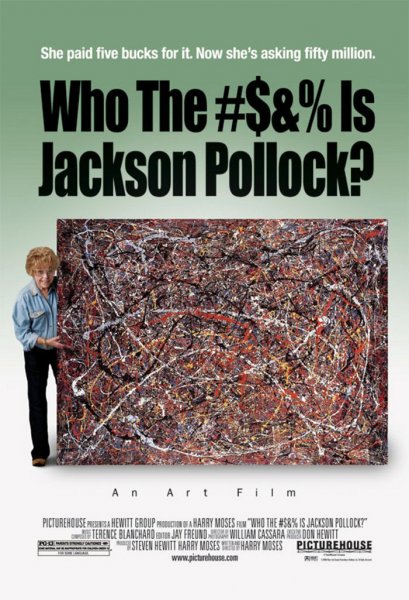
If you like this film, let us know!
- Infos
- Casting
- Technical infos
- Photos
- Videos
- Film quotes
- Characters
- Music
- Awards
Who the #$&% Is Jackson Pollock? is a documentary following a woman named Teri Horton, a 73-year-old former long-haul truck driver from California, who purchased a painting from a thrift shop for $5, only later to find out that it may be a Jackson Pollock painting; she had no clue at the time who Jackson Pollock was, hence the name of the film.
According to an interview from the film, Horton purchased the painting from a California thrift shop as a gift for a friend who was feeling depressed. Horton thought the bright colors were cheery, but when the dinner-table-sized painting proved too large to fit into her friend's trailer, Horton set it out among other items at a yard sale, where a local art teacher spotted it and suggested that the work could have been painted by Pollock due to the similarity to his action painting technique. At one point Horton and her friend decided the painting would be good for target practice, but they never got around to trying that activity. The film depicts Horton's attempts to authenticate and sell the painting as an original work by Pollock. Its authenticity was doubtful, because the painting was purchased at a thrift store, is unsigned, and is without provenance. The main problem with the painting is that it "does not have the soul of a Pollock," according to collectors. In addition, Pollock had many imitators during his lifetime. However a forensic specialist matched a fingerprint on the painting with those on two authenticated Pollocks and a can of paint in his studio, as well as finding other evidence. On another level, the movie explores the challenges faced by an average, but determined, citizen who takes on the elitist, high-stakes world of art dealership.
Some art connoisseurs, including Thomas Hoving, former director of the Metropolitan Museum of Art in New York, believe the painting to be inauthentic, while Nicolas Carone, an artist and friend of Pollock’s, is uncertain. Horton hired Peter Paul Biro, a Montreal-based forensic art expert, who matched a partial fingerprint on the canvas to a fingerprint on a can of paint in Pollock’s studio, as well as to fingerprints on two authenticated Pollock canvases. Additionally, through an analysis of paint samples from Pollock's studio, he was able to confirm a match with particles of paint found on the canvas in question, in what he calls a "3-point-match". However, in a June 2008 article in ARTnews, Sylvia Hochfield cited two forensic experts who called into question Biro's fingerprint analysis; similar concerns were raised in July 2010 by David Grann in an article for The New Yorker. In a pivotal point in the film, Horton's painting is compared side-by-side with Pollock's No. 5, 1948, a drip painting once owned by Samuel Irving Newhouse, Jr., CEO of Advance Publications, owner of Condé Nast, publisher of the The New Yorker. Horton then approached Tod Volpe, an art market trendsetter and former high-profile dealer, after reading his mémoire "Framed" to solicit his help in selling her painting. With Volpe's vision a business venture was formed, Legends Art Group, to manage and sell works of art authenticated by science; the formation of this venture is discussed in the documentary.
Volpe also brought Horton's story to producer Steven Hewitt, who, along with his father, executive producer Don Hewitt (creator of 60 Minutes), had formed the Hewitt Group to produce documentaries. Harry Moses, an Emmy, Peabody, and Directors Guild of America award-winner, and a recipient of a lifetime achievement award from the National Academy of Television Arts and Sciences, is the film's other producer, as well as its director and writer.
Horton, who appeared on The Montel Williams Show, The Tonight Show with Jay Leno, and the Late Show with David Letterman with the painting, turned down an offer Volpe secured for her of US $9 million from a Saudi Arabian buyer, and says she will take no less than $50 million for the painting.
A May 2012 article reveals a 2006 audio tape interview with Nicolas Carone, in which he admits being "advised" not to give his true opinion on camera, when in fact he believed the painting to be authentic, as did his family.
Comments
Leave comment :
Suggestions of similar film to Who the #$&% Is Jackson Pollock?
There are 8975 with the same cinematographic genres, 2533 films with the same themes (including 136 films with the same 2 themes than Who the #$&% Is Jackson Pollock?), to have finally 70 suggestions of similar films.If you liked Who the #$&% Is Jackson Pollock?, you will probably like those similar films :
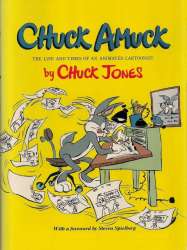
Chuck Amuck: The Movie (1991)
Origin USA
Genres Documentary, Animation
Themes Documentary films about business, Documentary films about the visual arts, Documentary films about the film industry, Documentaire sur une personnalité, Children's films
Actors Chuck Jones
Rating68%






My Kid Could Paint That (2007)
, 1h22Directed by Amir Bar-Lev
Origin USA
Genres Documentary
Themes Films about children, Documentary films about the visual arts, Documentaire sur une personnalité
Actors Amir Bar-Lev
Rating70%





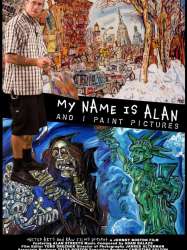
Origin USA
Genres Documentary
Themes Medical-themed films, Documentary films about the visual arts, Documentaire sur une personnalité, Documentary films about health care, Films about psychiatry, Films about disabilities
Rating68%






The Mindscape of Alan Moore (2003)
Genres Documentary
Themes Documentary films about the visual arts, Documentaire sur une personnalité
Actors Alan Moore
Rating74%





Alan Moore presents the story of his development as an artist, starting with his childhood and working through to his comics career and impact on that medium, and his emerging interest in magic.
 , 21minutes
, 21minutesDirected by Tom Neff
Origin USA
Genres Documentary
Themes Documentary films about the visual arts, Documentaire sur une personnalité
Rating71%





Barbara Haskell, the curator at the Whitney Museum of American Art, offers her insight into Grooms's art pieces and their place within twentieth-century art.
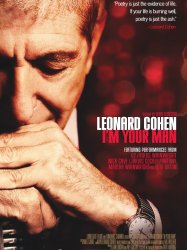
Leonard Cohen: I'm Your Man (2006)
, 1h43Directed by Lian Lunson
Origin USA
Genres Biography, Documentary, Musical
Themes Films about music and musicians, Poésie, Documentary films about the visual arts, Documentary films about music and musicians, Documentaire sur une personnalité, Musical films, Documentaire sur la poésie
Actors Nick Cave, Jarvis Cocker, Bono
Rating67%





En janvier 2005, à Sydney, Hal Willner conviait des artistes tels que Nick Cave, U2, Beth Orton Rufus Wainwright ou Jarvis Cocker à un concert-hommage à Leonard Cohen. Ce film est un témoignage de cette soirée exceptionnelle, assorti d'un entretien, réalisé pour l'occasion, avec le chanteur canadien.
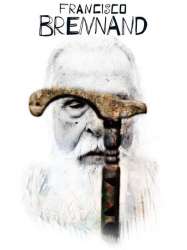
Francisco Brennand (2012)
, 1h15Origin Bresil
Genres Biography, Documentary, Historical
Themes Documentary films about the visual arts, Documentaire sur une personnalité
Rating63%





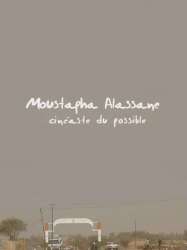 , 1h33
, 1h33Origin France
Genres Documentary
Themes Documentary films about business, Documentary films about the visual arts, Documentary films about the film industry, Documentaire sur une personnalité
Actors Moustapha Alassane
Moustapha Alassane is a living legend in African cinema. His adventures take us to the era of “pre-cinema”, to the times of magical lantern and Chinese shadows. He is the first director of Nigerien cinema and animation films in Africa. He tells very old stories with current technology, but he also narrates the most current events with the most archaic means. This documentary not only tells the adventure of a human being and an extraordinary professional, but the memories of a generation, the history of a country, Niger, in its golden age of cinema.
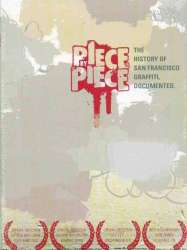
Piece By Piece (2005)
, 1h18Directed by Nic Hill
Origin USA
Genres Documentary
Themes Documentary films about the visual arts, Documentaire sur une personnalité
Rating72%





The first segment of Piece by Piece lays out the fundamentals of San Francisco graffiti by documenting topics that laid the groundwork for artists today. Items covered are “Cholo” writing, the impact of PBS's Style Wars (1983), and the development of San Francisco's defined style. This segment includes not only San Francisco's graffiti originals, but also commentary from noted New York writers such as Seen, Cope2 and Case2. It also covers the life and death of Dream One, a San Francisco graffiti pioneer and a vocal figurehead in Bay Area urban welfare activism.
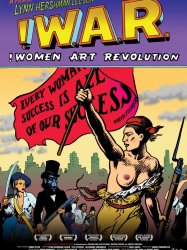 , 1h23
, 1h23Origin USA
Genres Documentary
Themes Feminist films, Documentary films about the visual arts, Documentaire sur une personnalité, Documentary films about politics, Political films
Actors Miranda July, Yoko Ono, Carolee Schneemann
Rating66%





!Women Art Revolution explores the "secret history" of feminist art, through conversations, observations, archival footage, and works of visionary artists, historians, curators and critics. Starting from its roots in 1960s antiwar and civil rights protests, the film details major developments in feminist art through the 1970s and explores how the tenacity and courage of these pioneering artists resulted in what is now widely regarded as the most significant art movement of the late 20th century.
 Connection
Connection